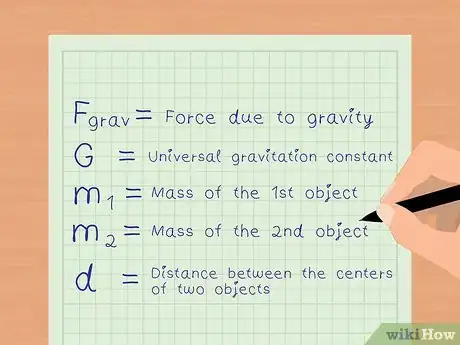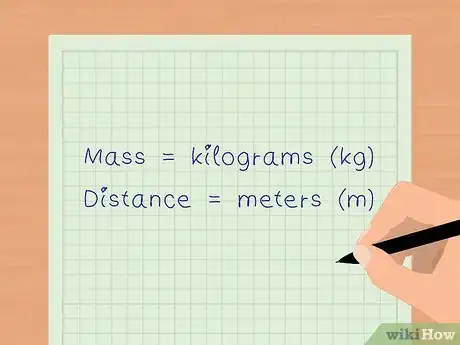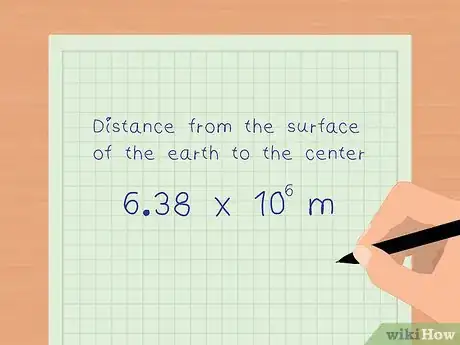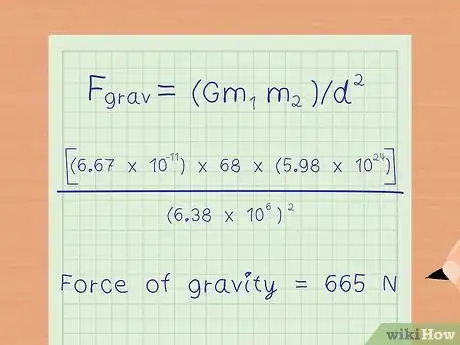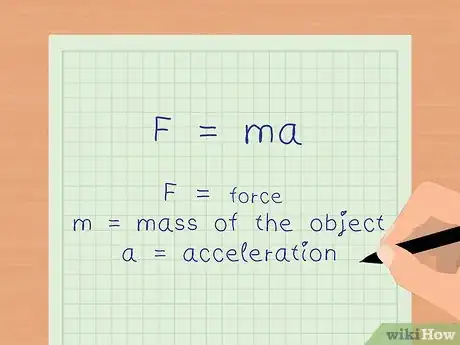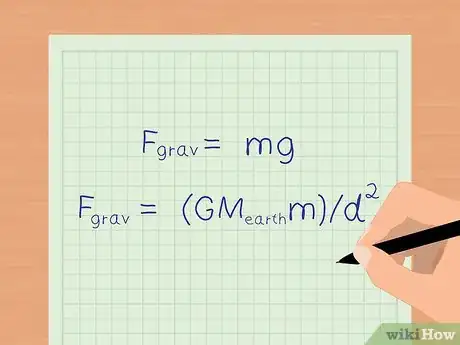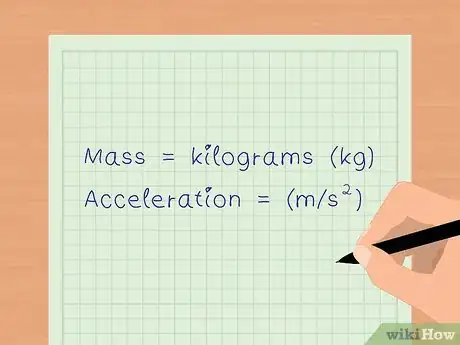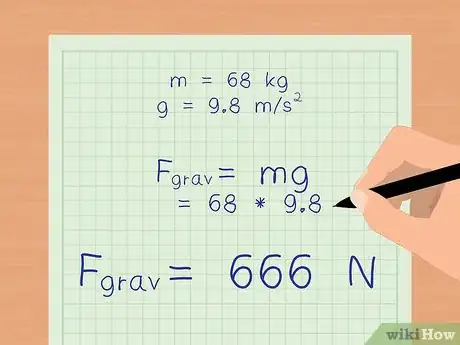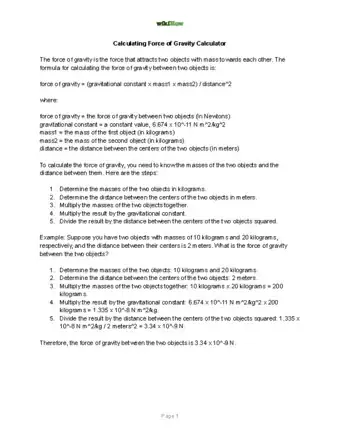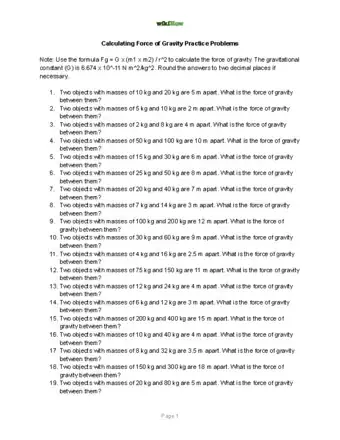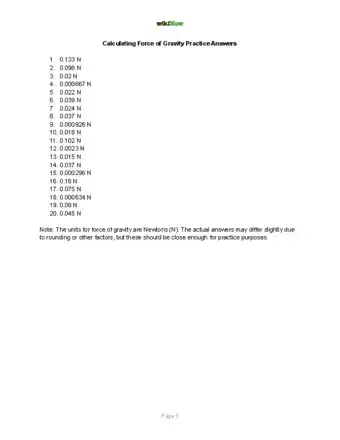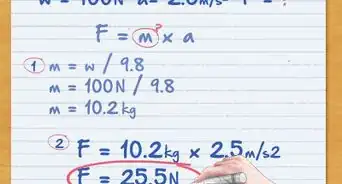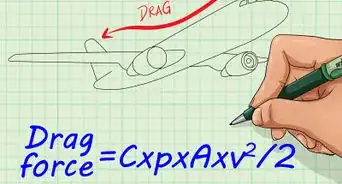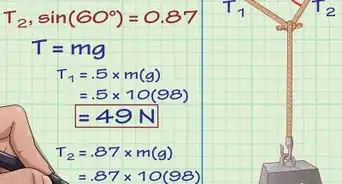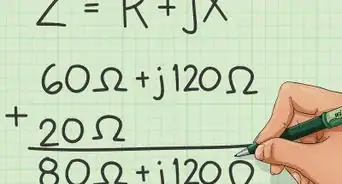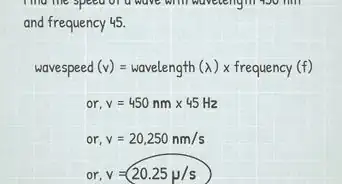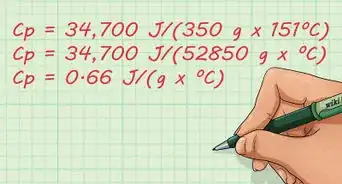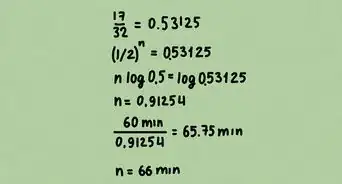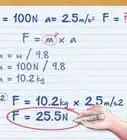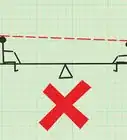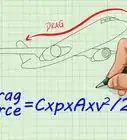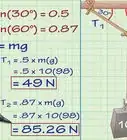This article was co-authored by wikiHow Staff. Our trained team of editors and researchers validate articles for accuracy and comprehensiveness. wikiHow's Content Management Team carefully monitors the work from our editorial staff to ensure that each article is backed by trusted research and meets our high quality standards.
This article has been viewed 610,494 times.
Learn more...
Gravity is one of the fundamental forces of physics. The most important aspect of gravity is that it is universal: all objects have a gravitational force that attracts other objects to them.[1] The force of gravity acting on any object is dependent upon the masses of both objects and the distance between them.[2]
Steps
Calculating the Force of Gravity Between Two Objects
-
1Define the equation for the force of gravity that attracts an object, Fgrav = (Gm1m2)/d2.[3] In order to properly calculate the gravitational force on an object, this equation takes into account the masses of both objects and how far apart the objects are from each other. The variables are defined below.
- Fgrav is the force due to gravity
- G is the universal gravitation constant 6.673 x 10-11 Nm2/kg2[4]
- m1 is the mass of the first object
- m2 is the mass of the second object
- d is the distance between the centers of two objects
- Sometimes you will see the letter r instead of the letter d. Both symbols represent the distance between the two objects.
-
2Use the proper metric units. For this particular equation, you must use metric units. The masses of objects need to be in kilograms (kg) and the distance needs to be in meters (m). You must convert to these units before continuing with the calculation.Advertisement
-
3Determine the mass of the object in question. For smaller objects, you can weigh them on a scale or balance to determine their weight in grams. For larger objects, you will have to look-up the approximate mass in a table or online. In physics problems, the mass of the object will generally be provided to you.[5]
-
4Measure the distance between the two objects. If you are trying to calculate the force of gravity between an object and the earth, you need to determine how far away the object is from the center of the earth.[6]
-
5Solve the equation. Once you have defined the variables of your equation, you can plug them in and solve. Be sure that all of your units are in metric and on the right scale. Mass should be in kilograms and distance in meters. Solve the equation using the proper order of operations.[9]
- For example: Determine the force of gravity on a 68 kg person on the surface of the earth. The mass of the earth is 5.98 x 1024 kg.[10]
- Make sure all your variables have the proper units. m1 = 5.98 x 1024 kg, m2 = 68 kg, G = 6.673 x 10-11 Nm2/kg2, and d = 6.38 x 106 m
- Write your equation: Fgrav = (Gm1m2)/d2 = [(6.67 x 10-11) x 68 x (5.98 x 1024)]/(6.38 x 106)2
- Multiply the masses of the two objects together. 68 x (5.98 x 1024) = 4.06 x 1026
- Multiply the product of m1 and m2 by the gravitational constant G. (4.06 x 1026) x (6.67 x 10-11) = 2.708 x 1016
- Square the distance between the two objects. (6.38 x 106)2 = 4.07 x 1013
- Divide the product of G x m1 x m2 by the distance squared to find the force of gravity in Newtons (N). 2.708 x 1016/4.07 x 1013 = 665 N
- The force of gravity is 665 N.
Calculating the Force of Gravity on Earth
-
1Understand Newton’s Second Law of Motion, F = ma. Newton’s second law of motion states that any object will accelerate when acted upon by a net or unbalanced force.[11] In other words, if a force is acting upon an object that is greater than the forces acting in the opposite direction, the object will accelerate in the direction of the larger force.
- This law can be summed up with the equation F = ma, where F is the force, m is the mass of the object, and a is acceleration.
- Using this law, we can calculate the force of gravity of any object on the surface of the earth, using the known acceleration due to gravity.
-
2Know the acceleration due to gravity on earth. On earth, the force of gravity causes objects to accelerate at a rate of 9.8 m/s2. On the earth’s surface, we can use the simplified equation Fgrav = mg to calculate the force of gravity.
- If you want a more exact approximation of force, you can still use the above equation, Fgrav = (GMearthm)/d2 to determine force of gravity.
-
3Use the proper metric units. For this particular equation, you must use metric units. The mass of the object needs to be in kilograms (kg) and the acceleration needs to be in meters per second squared (m/s2). You must convert to these units before continuing with the calculation.
-
4Determine the mass of the object in question. For smaller objects, you can weigh them on a scale or balance to determine its weight in kilograms (kg). For larger objects, you will have to look-up the approximate mass in a table or online. In physics problems, the mass of the object will generally be provided to you.[12]
-
5Solve the equation. Once you have defined the variables of your equation, you can plug them in and solve. Be sure that all of your units are in metric and on the right scale. Mass should be in kilograms and distance in meters. Solve the equation using the proper order of operations.[13]
- Let’s use the same equation from above and see how close the approximation is. Determine the force of gravity on a 68 kg person on the surface of the earth.
- Make sure all your variables have the proper units: m = 68 kg, g = 9.8 m/s2.
- Write your equation. Fgrav = mg = 68*9.8 = 666 N.
- With F = mg the force of gravity is 666 N, while using the more exact equation yields a force of 665 N. As you can see, these values are almost identical.
Calculator, Practice Problems, and Answers
Community Q&A
-
QuestionHow do I find the mass of the moon?
 Community AnswerCheck out same steps as mentioned below. But remember gravity on moon is 1/6th of gravity on earth.
Community AnswerCheck out same steps as mentioned below. But remember gravity on moon is 1/6th of gravity on earth. -
QuestionA mass of 25 kg weighs 123 Newtons on another planet. What is the gravity on the planet?
 Community AnswerThe "gravity" on the surface of a planet is it's acceleration (the rate of increase in speed as an object falls). Fg (the force of gravity) is m x g (acceleration of gravity), in m/(s squared), so g is Fg / m = 123 N / 25 kg ~= 4.92 m/(s squared).
Community AnswerThe "gravity" on the surface of a planet is it's acceleration (the rate of increase in speed as an object falls). Fg (the force of gravity) is m x g (acceleration of gravity), in m/(s squared), so g is Fg / m = 123 N / 25 kg ~= 4.92 m/(s squared). -
QuestionHow do I find the value of acceleration due to a gravity at a height of 2R from the surface of the earth?
 Community AnswerIf you want to know what the gravity would be when you are 3 earth-radii away from the center of earth, then the gravity would be 1/9th normal gravity. You're multiplying by 3 on the bottom, so 1/3, but then it's squared. Acceleration would then be 1.09 meters per second squared.
Community AnswerIf you want to know what the gravity would be when you are 3 earth-radii away from the center of earth, then the gravity would be 1/9th normal gravity. You're multiplying by 3 on the bottom, so 1/3, but then it's squared. Acceleration would then be 1.09 meters per second squared.
References
- ↑ http://www.physicsclassroom.com/class/circles/Lesson-3/Newton-s-Law-of-Universal-Gravitation
- ↑ http://www.physicsclassroom.com/class/circles/Lesson-3/Newton-s-Law-of-Universal-Gravitation
- ↑ http://www.physicsclassroom.com/class/circles/Lesson-3/Newton-s-Law-of-Universal-Gravitation
- ↑ http://www.physicsclassroom.com/class/circles/Lesson-3/Newton-s-Law-of-Universal-Gravitation
- ↑ https://www.omnicalculator.com/physics/gravitational-force
- ↑ http://www.physicsclassroom.com/class/circles/Lesson-3/The-Value-of-g
- ↑ http://www.physicsclassroom.com/class/circles/Lesson-3/The-Value-of-g
- ↑ http://www.physicsclassroom.com/class/circles/Lesson-3/The-Value-of-g
- ↑ https://www.omnicalculator.com/physics/gravitational-force
About This Article
To calculate the force of gravity of an object, use the formula: force of gravity = mg, where m is the mass of the object and g is the acceleration of the object due to gravity. Since g is always 9.8 m/s^2, just multiply the object's mass by 9.8 and you'll get its force of gravity! If you want to learn how to calculate the force of gravity between 2 objects, keep reading the article!
